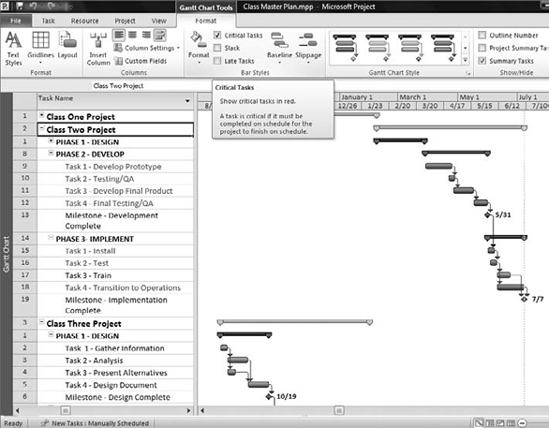1. Default Settings
By default, after you create a master file with
inserted subprojects, Project calculates one critical path, taking all
the projects into consideration. The subproject or inserted project
schedule with the last task or milestone drives what is on the critical
path for all the other inserted projects. In Figure 1,
Class Two Project finishes later than Class Three Project and therefore
is on the critical path, whereas Class Three Project isn't.
When you insert a project into the master file, the
source file inherits the characteristics of the critical path driven
from the master. If Class Three Project isn't on the critical path and
none of its tasks are in the master, then when you view it in the source
file, it doesn't display any tasks on the critical path. In Figure 2, even though critical path formatting is turned on, no tasks appear on the critical path.


To display the critical path, select Format tab => Bar Styles group => Critical Paths.
2. Changing the Settings
The problem with inserting projects into a master is
that by default, you lose the ability to view the critical path for an
individual inserted project. However, you can change the settings so
that you can do so.
By default, Project treats each inserted project like another summary task or phase. To change this setting, follow these steps:
Click the File tab to access the backstage.
In the Project Options dialog box, click the Schedule tab.
Scroll down until you find Calculation Options for This Project.
Deselect the Inserted Projects Are Calculated Like Summary Tasks check box, as shown in Figure 3.
Class Three Project now has its own critical path, as
will all the inserted projects. When you run the critical-path
formatting in the source file, it also displays its own critical path.
You can adjust the option setting depending on how you want to view the
critical path.

Working with a large product-development company, I
had to create a master plan that displayed the critical path across
multiple projects. First, I developed an individual project schedule for
each subproject that had a separate project manager who was responsible
for maintaining the project file.
After creating the schedules, I created a master file
with all the inserted subprojects. Then, I held an integration meeting
with the project managers to establish the cross-project links in the
master plan, with input from each of the stakeholders. Subsequently,
each project manager could view the external ghost tasks in their source
plans and immediately see the impact of slippage or change on any of
the external tasks. This ultimately broke down barriers among the groups
and allowed them to make quicker, more effective decisions based on
changes and delays.
Everyone had read-only access to the master file so they could access the details of other project schedules if needed.